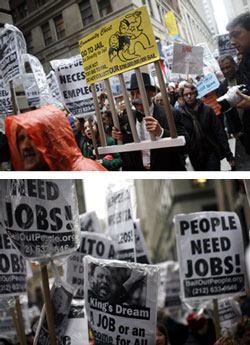No more money for the bankers, more help for people, say marchers
NEW YORK (FinalCall.com) – For two days protesters representing youth groups, immigrants’ rights advocates, anti-war activists, unions, health care workers and the homeless marched around Wall Street, the symbol of America’s financial power, to demand a “bail out for the people not the banks.”
There was no civil disturbance or breaking of glass, as was the case in London during the G-20 meeting, when protesters broke the windows of the Bank of Scotland. However, four people were arrested on April 3 because they walked down a street police said was off-limits.

Larry Holmes, an organizer with Bail Out The People, said, “It’s an outrage that police are arresting youth and working people who are doing nothing more than demanding a real bailout for the people. The criminals are in the offices of AIG, Citigroup, Bear Sterns and other financial institutions who have robbed trillions of dollars of the people’s money.”
The marchers were not allowed on Wall Street on the first day, but that did not dampen their spirits as they marched Friday, April 4 to the offices of AIG, American Express, Chase and Citigroup, ending at Foley Square where immigrant workers are processed for green cards.
“We think Friday’s demonstration was very effective,” Mr. Holmes told The Final Call. “It was a productive day because workers were well represented,” he added.
On April 4, the anniversary of the assassination of Dr. Martin Luther King Jr., marchers were allowed to pass by the New York Stock Exchange on their way to Battery Park, where drummers played, poets performed skits and organizations set up tables and disseminated information about the recent financial crisis.
“People are organizing across the country against this so-called recession, but it is not being publicized,” Brenda Stokely, an organizer for the Million Worker March, told The Final Call.
Asked why there weren’t thousands of people participating in the two-day protest, Ms. Stokely said, “People are still waiting to give President Barack Obama’s ‘Stimulus Package’ a chance to work.”
“But,” she cautioned, “in the long run people are going to come to the conclusion that they are going to have to create their own jobs, grow their own food and stop putting their money in these banks.”
Activists and analysts say the key to the Bail Out The People movement is mobilizing workers.
The Congressional Black Caucus reported that unemployment for Blacks nationally was 13.3 percent, up 5.4 percent since December 2007. The CBC said the number of Blacks with jobs dropped to 54.1 percent, the lowest number since April 1993. The CBC also noted that the unemployment rate for Black men 20 or over is 15.4 percent which is 7.2 percent higher then when the recession started–one in six Black men is unemployed.
The New York State Department of Labor said in a new report that New York City witnessed its highest month-to-month rise in unemployment ever recorded, with a jump to 8.1 percent in February, up from 6.9 percent in January. One reason for the spike, according to Brooklyn Congressman Anthony Weiner, a Democrat, is that 12 percent of the small businesses in the outer-boroughs, not including Manhattan, are boarded up and in the process of closing.
The congressman said these “ma and pa” businesses traditionally account for 70 percent of new jobs.
So, asked protesters, “Why is the government spending trillions of dollars to prop up a failing financial system?”
The Center for Economic & Policy Research reported that the Obama administration’s Public-Private-Partnership Program’s trillion dollar bailout equals 300 million years of state sponsored health care for children, so the money could be put to a better use.
The Revolutionary Organiza-tion of Labor, USA passed out literature with its solutions: “No more bail out for the wealthy; nationalize the banks; strengthen social security and expand its benefits; stop home foreclosures and evictions of renters due to predatory lending and create millions of decent jobs through a massive public works program at a living wage.”
Jim Haughton, a New York labor activist and a former Labor Studies professor at Princeton University, said workers are the key to pulling America up out of this latest crisis. But Black and Latino workers are going to have to build coalitions with White and Asian workers, he argued.
“Taking to the streets is not the answer. We have to become strategists using critical thinking and unity as our tools for change,” Mr. Haughton told The Final Call. “The real agenda for Black and Latino workers is to build an organization with real leadership that will challenge the American establishment that controls us and Black folk alone cannot advance this struggle,” he insisted.












